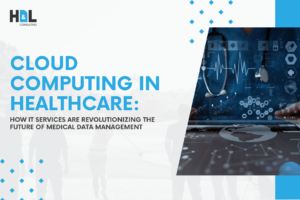In the modern, rapidly developing world with its extensive integration of information technologies, the sphere of healthcare is increasingly adopting this very technology to try to ease the workload and make the care of patients more efficient. The challenge of managing and securing highly sensitive patient data arises with the rapid digital transformation. This high value has turned the healthcare sector into one of the major targets of cybercriminals, and cybersecurity has become a highly critical issue. In this blog, we’re going to discuss some challenges the healthcare organizations face in maintaining cybersecurity and how IT services will play a very critical role in safeguarding patient data. Importance of Cybersecurity in Healthcare.
Health organizations handle hundreds of thousands of records that include patients’ medical history, diagnosis, treatments, insurance data, and details about payments.
This type of data, in some circles referred to as Protected Health Information, carries immense value to a hacker. If compromised, it could lead to identity theft, financial fraud, or being sold on the black market. In fact, data breaches are considerably more expensive in the healthcare industry compared to other sectors, standing at an estimated average cost per breach of $10.1 million in the 2022 Cost of a Data Breach Report by IBM. But cybersecurity in healthcare is not about the protection of data per se; it is about the trust of patients in healthcare providers. Breach of that trust leads to reputational consequences, legal consequences, and financial losses. This means good cybersecurity measures should be enforced, not only to protect the data itself but also to protect healthcare service integrity and functionality. Major Cybersecurity Challenges in Healthcare
Ransomware Attacks Ransomware attacks are one of the most common threats in healthcare, as, through this, the hackers lock the systems and demand a ransom for their release. This is quite critical for hospitals or clinics since they require timely access to medical data. In a report by Sophos in 2021, it was recorded that 34% of healthcare organizations were hit by ransomware during the previous year, which seriously disrupted operations.
Moreover, cyber criminals have also used phishing to access sensitive health care systems. Additionally, sometimes employees accidentally click on links or attachments of malicious emails, allowing attackers to access patient records or administrative systems. The health industry is still under pressure, so employees may not pay much heed to the signs of phishing, which consequently increases the chances of an attack.
Insider Threats Insider threats consist of malicious and accidental activities and make up a good amount of the breaches in health care. Some employees have access to sensitive information, which could be misused by them for personal gains, or they can leak out information unconsciously with poor cybersecurity hygiene. The Verizon 2021 Data Breach Investigations Report mentions that insider threats were involved in 25% of all data breaches in health care.

Insecure Legacy Systems and Software: Most of the healthcare organizations either depend on their legacy systems or older software versions, which are no longer supported with security patches. This makes them very easy to exploit. Most of the older systems do not have encryption, and many of these may not be able to host modern cybersecurity protocols, hence becoming a prime target for cyberattacks.
Wearables and IoT: New Risks Developed Because of the Rise of Internet of Things in Healthcare Devices like pacemakers and insulin pumps, even monitoring systems in hospitals, have remote access pathways which could be a source of vulnerability unless correctly secured. Also, the wearables and telemedicine are increasingly deployed, making the attack surface wider.
Third-Party Vendors Healthcare organizations contract for services such as billing, transcription, or cloud storage from third-party vendors. These business associates might not invest in cybersecurity measures as a healthcare organization would do, thus becoming the weak link in the chain. A data breach at the end of a third-party vendor can have direct consequences for the healthcare provider.
How IT Services Address These Cybersecurity Challenges
For this reason, medical institutions should consider the adoption of IT services that would ensure the security of patient information against these cybersecurity threats. Such IT services, in turn, aim to minimize these risks through multi-layered security models that cover prevention and response.
1. All-Encompassing Security Auditing and Risk Assessment
IT services conduct regular security audits and vulnerability assessments to identify loopholes in healthcare systems. In so doing, healthcare providers realize the possibility of a risk, hence the need to implement corrections. By finding the weaknesses before cybercriminals do, healthcare organizations avoid expensive breaches.
2. Employee Training and Awareness Programs
The human factor is also one of the leading causes for security breaches in healthcare. IT services alleviate this vulnerability through training programs that would keep employees updated on best practices in cybersecurity, such as recognizing phishing attempts, using secure passwords, and locking their devices. Continuous training keeps staff alert and updates about the latest vulnerabilities.
3. Advanced Encryption and Data Protection
One of the most critical components for healthcare cybersecurity is encryption. IT services ensure all data, whether at rest or in transit, is encrypted. This process makes the data unreadable to those who do not have authorized access, thus it will be much harder for hackers in case of a security breach to obtain important information.
4. Multi-factor Authentication
IT services are deploying multi-factor authentication in a way that a user needs to get through two or more verification methods before access is granted. This may include password, fingerprint, or others. In such cases, the chances of credential theft are greatly reduced.
5. Patch Management and Updates
The IT services play a major role in updating all software and systems with the latest security patches. Any outdated legacy systems and software open themselves to hackers because of no timely update for closing the security gaps.
6. Network Security and Monitoring
IT services implement complex firewalls, intrusion detection systems, and intrusion prevention systems that monitor network activities for unauthorized access. This is made possible as IT services continuously monitor network activities for unusual behavior and can identify and respond to real-time threats.
7. Incident Response Planning and Disaster Recovery
Each of them has an incident response plan in place in case a breach occurs, which helps in limiting the breach. IT services develop an extensive incident response plan with healthcare organizations on how to respond to a cyberattack, including system isolation, stakeholder notification, and data recovery. Furthermore, the disaster recovery plans ensure that operations for healthcare providers are restored as soon as possible after an attack. This ensures them of minimal operation downtown and patient disruption.
8. Compliance with Healthcare Regulations
IT services ensure that healthcare organizations remain in compliance with industry regulations such as the Health Insurance Portability and Accountability Act of the U.S., the General Data Protection Regulation of Europe, and other local data protection laws. For all these regulations, there should be tight data security with regular audits to ensure continued protection.

Final Thoughts:
Cybersecurity in the healthcare industry is continuously changing and will always require some degree of alertness and strategic proactive measures. As care provider organizations move further into digital transformation, the role for IT services in healthcare to provide added value on the protection of sensitive patient information has never been more critical. Advanced encryption, multi-factor authentication, routine software updates, and employee training round out the different types of tools and strategies that IT services provide to help protect against constantly changing cyber threats.
Health practitioners can protect sensitive patient information, retain trust, and ensure compliance, thus improving standards of care, by making investments that involve comprehensive cybersecurity strategies. As the healthcare industry continues to evolve, so must efforts to keep it secure from cyberattacks.
If you are looking for an experienced IT provider, H&L Consulting is the best option. With years of experience, we specialize in mobile app development, web app development, staff augmentation, and robot process automation. Our staff of over 30 highly qualified IT consultants and developers can handle projects of any scale. We are committed to supporting your goals after successfully delivering over 50 solutions to clients throughout the world. Contact us for a full discussion, knowing that H&L Consulting is prepared to fulfill all your IT demands with specialized, effective solutions.









